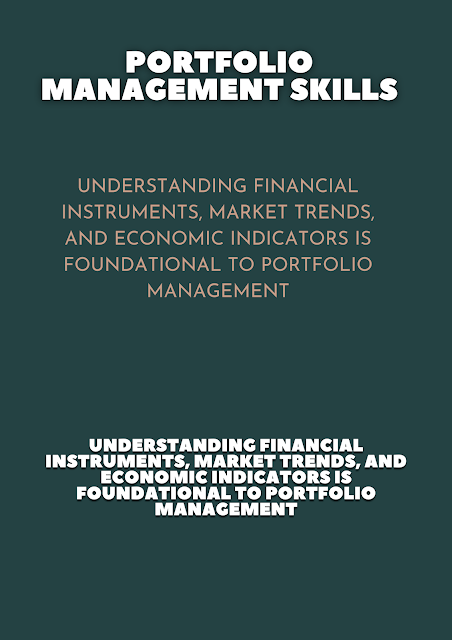Portfolio Management Skills
Introduction
Portfolio management is a crucial discipline in finance that involves the art and science of making investment decisions to maximize returns while minimizing risks. It requires a combination of analytical expertise, strategic thinking, and risk assessment. Whether for individual investors or institutional fund managers, developing robust portfolio management skills is essential for achieving long-term financial goals.
1. Financial Literacy and Market Awareness
Understanding financial instruments, market trends, and economic indicators is foundational to portfolio management. Research indicates that financially literate investors make more informed and rational decisions (Lusardi & Mitchell, 2014). Financial literacy involves grasping concepts such as:
Stock market fluctuations: Analyzing historical trends and understanding economic cycles.
Alternative investments: Commodities, cryptocurrencies, and real estate as diversification tools.
Scientific Evidence: A study by van Rooij, Lusardi, and Alessie (2011) found that financially literate investors are more likely to engage in stock market participation and achieve higher returns.
2. Risk Assessment and Management
Risk is an inherent part of investing, and successful portfolio managers must develop skills to measure and mitigate it effectively. Risk assessment involves understanding:
Volatility measurement: Standard deviation and beta calculations.
Diversification strategies: The Modern Portfolio Theory (MPT) by Markowitz (1952) emphasizes spreading investments across different asset classes to reduce risk.
Stress testing and scenario analysis: Simulating different market conditions to predict portfolio behavior.
Scientific Evidence: A study published in the Journal of Banking & Finance (Kritzman et al., 2010) highlights that diversified portfolios exhibit lower volatility and improved stability over time.
3. Asset Allocation and Diversification
Proper asset allocation is a critical portfolio management skill. It involves dividing investments among different asset categories to optimize returns while minimizing risk. The core asset classes include:
Equities: Growth potential but high volatility.
Fixed income: Stability through bonds and treasury securities.
Real estate and commodities: Inflation hedging and diversification benefits.
Scientific Evidence: Brinson, Hood, and Beebower (1986) found that asset allocation accounts for over 90% of a portfolio's variability in returns, emphasizing its importance over stock selection and market timing.
4. Quantitative and Analytical Skills
Portfolio managers rely heavily on quantitative models to evaluate investment opportunities. These skills include:
Financial modeling: Discounted Cash Flow (DCF) and Monte Carlo simulations.
Statistical analysis: Using regression models to predict market movements.
Technical analysis: Chart patterns, moving averages, and momentum indicators.
Scientific Evidence: A report by Lo, Mamaysky, and Wang (2000) in The Journal of Finance suggests that technical analysis can be useful in predicting short-term price movements, while fundamental analysis is better for long-term valuation.
5. Decision-Making Under Uncertainty
Investment decisions often need to be made under conditions of uncertainty. Effective portfolio managers must:
Develop behavioral discipline: Avoid emotional trading based on fear or greed.
Use probability and Bayesian inference: Updating beliefs as new information becomes available.
Apply cognitive biases mitigation techniques: Anchoring, loss aversion, and overconfidence can impact decision-making.
Scientific Evidence: Kahneman and Tversky's (1979) Prospect Theory illustrates how investors tend to weigh potential losses more heavily than gains, leading to suboptimal decision-making.
6. Performance Measurement and Benchmarking
Evaluating portfolio performance against benchmarks ensures that investment strategies align with objectives. This involves:
Sharpe ratio: Risk-adjusted return measure.
Treynor ratio: Portfolio return per unit of systematic risk.
Jensen’s Alpha: Measuring excess returns beyond the expected performance of a benchmark.
Scientific Evidence: Fama and French (1993) introduced a three-factor model that provides a more comprehensive method of analyzing investment performance, beyond the traditional Capital Asset Pricing Model (CAPM).
7. Economic and Industry Analysis
Understanding macroeconomic trends and industry dynamics is essential for long-term portfolio success. Factors include:
Interest rates and inflation: Impacting bond yields and stock prices.
Geopolitical risks: Affecting international investments and currency fluctuations.
Sector rotation strategies: Allocating assets based on economic cycles.
Scientific Evidence: The Harvard Business Review (Porter, 1980) highlights industry structure analysis as a key determinant of competitive advantage, influencing investment decisions.
8. Technology and Automation in Portfolio Management
With the rise of machine learning, portfolio management is increasingly data-driven. Skills include:
Algorithmic trading: Using AI to execute trades at optimal prices.
Robo-advisors: Automating portfolio rebalancing.
Big data analytics: Predicting market trends using large datasets.
Scientific Evidence: A study by Narang (2013) in Quantitative Trading discusses how machine learning algorithms improve efficiency in trading strategies.
9. Regulatory Compliance and Ethical Considerations
Portfolio managers must adhere to legal frameworks and ethical guidelines. Compliance skills include:
Understanding securities laws: SEC regulations, fiduciary responsibilities.
Ethical investing principles: ESG (Environmental, Social, Governance) considerations.
Anti-money laundering (AML) compliance: Preventing financial crimes.
Scientific Evidence: Research by Eccles, Ioannou, and Serafeim (2014) in Harvard Business Review found that firms with strong ESG practices exhibit better long-term financial performance.
Conclusion
Mastering portfolio management requires a blend of analytical, strategic, and behavioral skills. Scientific research underscores the significance of financial literacy, risk assessment, asset allocation, and technological integration in optimizing investment outcomes. As financial markets evolve, continuous learning and adaptability remain key to success in portfolio management.
References
Brinson, G. P., Hood, L. R., & Beebower, G. L. (1986). Determinants of portfolio performance. Financial Analysts Journal, 42(4), 39-44.
Eccles, R. G., Ioannou, I., & Serafeim, G. (2014). The impact of corporate sustainability on organizational processes and performance. Harvard Business Review.
Fama, E. F., & French, K. R. (1993). Common risk factors in the returns on stocks and bonds. Journal of Financial Economics, 33(1), 3-56.
Kahneman, D., & Tversky, A. (1979). Prospect theory: An analysis of decision under risk. Econometrica, 47(2), 263-291.
Lusardi, A., & Mitchell, O. S. (2014). The economic importance of financial literacy: Theory and evidence. Journal of Economic Literature, 52(1), 5-44.
Markowitz, H. (1952). Portfolio selection. The Journal of Finance, 7(1), 77-91.
By mastering these skills, investors and portfolio managers can navigate the complexities of financial markets and build resilient, high-performing portfolios.









0 Comments